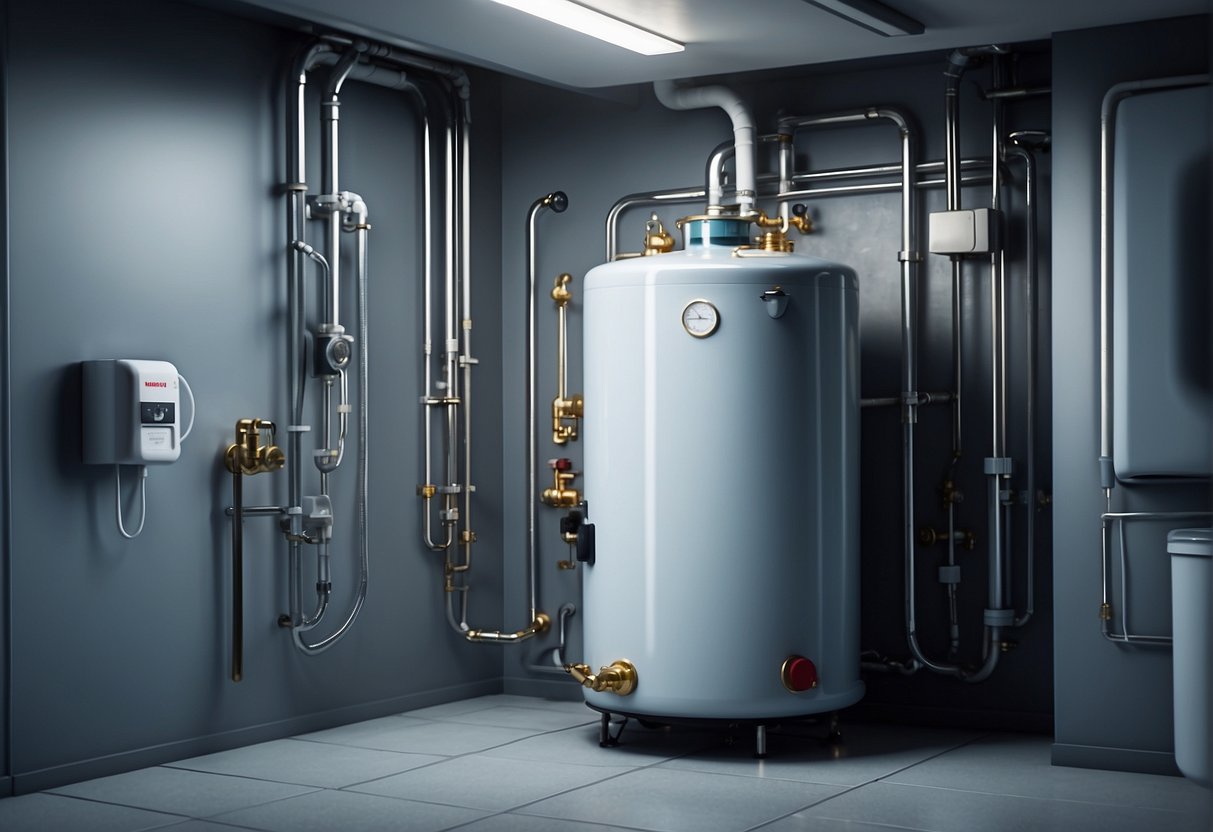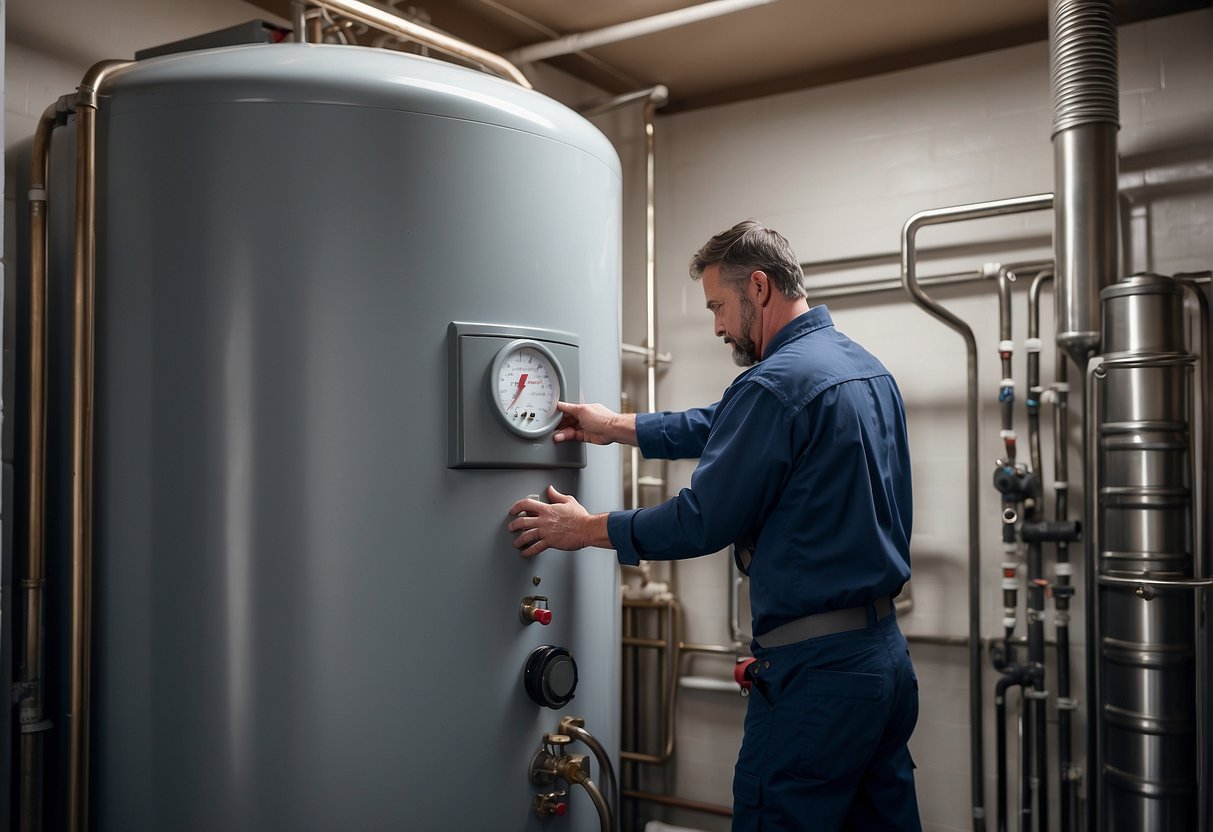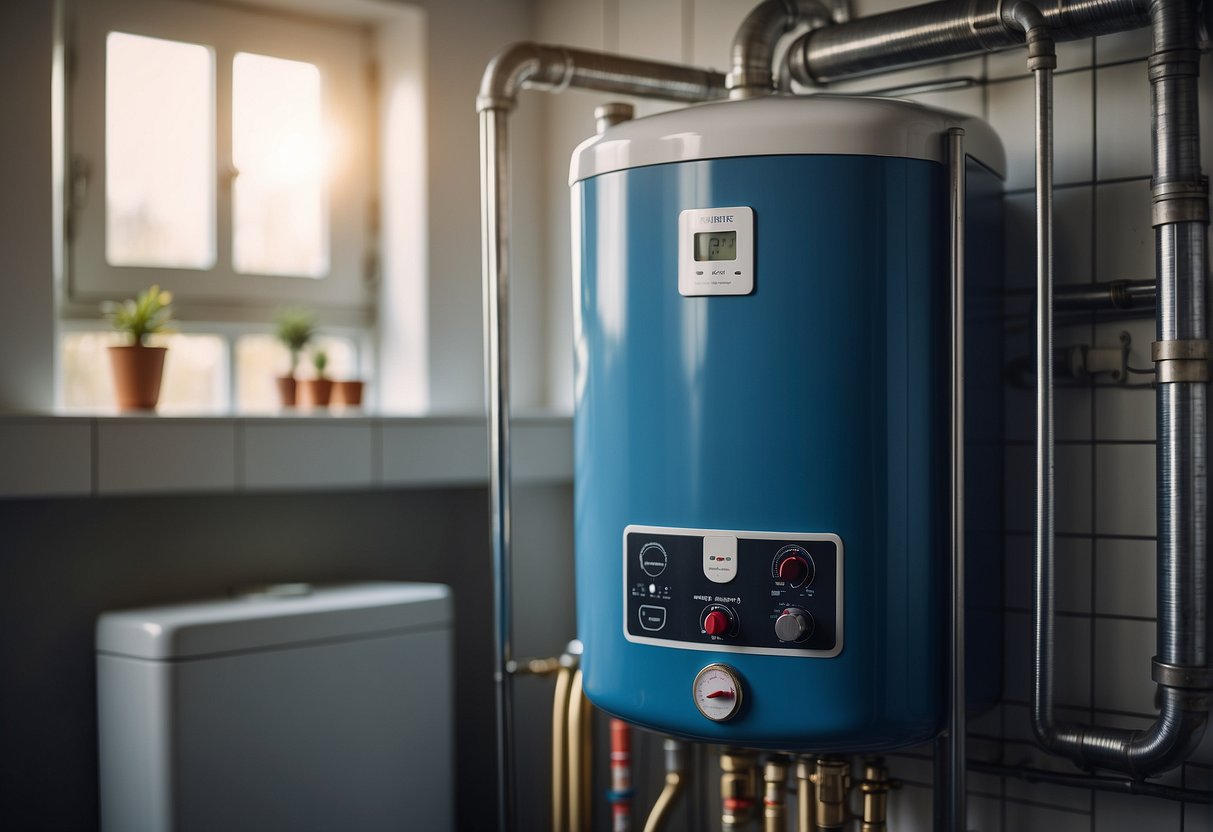A hot water tank, often found at the heart of a home’s heating system, serves the integral function of storing and providing a consistent supply of hot water.
In the UK, these tanks are essential for both domestic comfort and commercial operations, where consistently high demands for hot water are common.
Hot water tanks come in various capacities to suit different requirements and can be either direct or indirect in their heating, with each type using a unique method to heat the stored water.

The operation of a hot water tank involves a well-coordinated mechanism that maintains the water at the preferred temperature until it’s needed. With the help of thermostats and immersion heaters located within the tank, the water’s heat level is managed efficiently. This system guarantees a sufficient supply of hot water, even during times of high demand or if the boiler stops working.
Key Takeaways
- Hot water tanks play a crucial role in hot water supply for various applications.
- They rely on components like thermostats and immersion heaters for functionality.
- These tanks come in different types and sizes to meet specific needs.
Understanding Hot Water Tanks

Hot water tanks are integral to both domestic and commercial heating systems, playing a key role in providing consistent hot water. They are designed to store and heat water, ensuring that it is readily available when needed.
Basics of a Hot Water Tank
A hot water tank is a device within the heating system of a household or commercial establishment that stores hot water until it is required. In essence, it is a storage tank that keeps water at a preset temperature. The capacity of these tanks can vary significantly, from small units suitable for single-bedroom flats to large tanks designed for commercial use. The water is typically heated either by boiler connections or through electricity, using heating elements like immersion heaters.
Types of Hot Water Tanks
There are two primary types of hot water tanks: vented and unvented. Vented hot water tanks, also known as gravity-fed systems, require a cold water tank, usually located in the loft, and rely on gravity for pressure. In contrast, unvented hot water tanks operate at mains pressure and do not need a cold water storage tank, providing better water pressure and reducing the system’s footprint.
Within these categories, there are direct and indirect cylinders. A direct cylinder is heated by an internal element, whereas an indirect cylinder is heated via an external source, like a boiler or solar panels, with a heat exchanger transferring the heat to the water.
Components and Functionality
A hot water tank comprises several components, each playing a crucial role in its operation:
- Thermostat: Maintains the desired temperature by controlling the heating element.
- Heating Element: Usually an electric immersion heater that warms the water directly.
- Insulation Jacket: Reduces heat loss, ensuring efficient maintenance of water temperature.
- Expansion Tank: Prevents pressure build-up in the system.
- Heat Exchanger: Present in indirect systems, allowing heat transfer from the boiler to the water in the tank.
- Cold Water Inlet: Allows cold water to enter the tank from the mains or cold water tank.
- Hot Water Outlet: Channel through which the heated water is supplied to taps and other outlets.
The capacity of the tank should match the hot water demand, with larger households and facilities requiring greater volumes of hot water storage. Proper insulation and venting are essential for safety and energy efficiency, preventing the unnecessary loss of heat and regulating pressure within the tank.
Installation and Sizing

When considering the installation and sizing of a hot water tank, one must account for the specific hot water demand of the household or commercial establishment. The size directly impacts the capacity to deliver sufficient hot water for daily activities such as showers and central heating systems.
Selecting the Right Size
The selection of the right size for a hot water tank is crucial to meet the hot water requirements of a property. For a domestic property, the size is typically based on the number of bedrooms and bathrooms.
A common guideline suggests approximately 35-45 litres per individual for properties with mains pressure systems, such as with a combination boiler, while gravity-fed systems may require larger tanks due to lower pressure. In a commercial context, the demand calculations consider the frequency and simultaneous usage across multiple bathrooms and facilities.
A certified plumber can assess the demand and recommend a suitable hot water system that aligns with usage patterns and minimises the need for frequent maintenance.
Installation Process
The installation of a hot water tank involves a range of steps and should always be performed by a qualified plumber or heating engineer, adhering to UK plumbing regulations. Initially, the system, whether open or a pressurised setup, is chosen based on compatibility with the existing central heating system.
For the installation, the tank is typically situated in an area like an airing cupboard for domestic tanks, ensuring it is connected to both the drain and the mains water supply efficiently.
The plumber will secure the tank, connect it to necessary pipework for water and heating, and meticulously test the system to guarantee proper operation including the safe drainage and maintenance access.
Operating and Maintenance

The effectiveness of a hot water tank, whether used domestically or commercially, crucially depends on its proper operation and regular maintenance. These practices not only ensure a continuous supply of hot water but also safeguard the longevity of the system.
Daily Operation
The daily operation of a hot water tank involves managing its settings to meet the demand for hot water while considering energy efficiency. For electric water heaters, this includes setting the timer to activate heating during off-peak hours, which can reduce operating costs. Gas water heaters require checking the burner for a consistent blue flame, indicating efficient burning.
In direct systems, where the water is heated within the tank, it’s crucial to check the temperature settings and ensure the immersion heater is functioning correctly. Indirect systems, on the other hand, involve a separate boiler or central heating system that heats water before it’s stored in the tank, requiring coordination between the two systems’ timers and thermostats.
Troubleshooting Common Issues
Common issues with hot water tanks can often be resolved with basic troubleshooting steps. A drop in water pressure might signify blocked pipes or a malfunctioning pump. Maintenance checks here would include assessing the pressure gauge and clearing potential blockages. Signs of rust or leak dictate the need for immediate inspection, as they can lead to serious water damage or degradation of the tank’s integrity.
If a leak is discovered, isolating the cold tank and draining the system may be necessary before a repair or replacement. Burner problems in gas heaters typically present as irregular flames or no heat generation, requiring an examination of the gas supply, burner condition, and pilot light.
It’s essential to regularly service all components to mitigate these issues, focusing on reliability and to accommodate the demand for hot water without incurring unanticipated breakdowns or excessive repairs.
Contact us immediately for top-notch hot water cylinder repair service in Kent.
Benefits and Considerations
Hot water tanks are central to the functioning of both domestic and commercial properties, providing essential hot water for activities such as cooking, bathing, and washing. They must be considered carefully to balance their benefits against operating costs and environmental impact.
Advantages of Efficient Hot Water Tanks
Efficient hot water tanks offer significant advantages in terms of energy efficiency and reliability. An insulated hot water tank ensures that heat is retained, reducing operating costs and the need for continuous heating.
This can lead to considerable cost savings on both electricity and gas bills. In properties with sufficient space, installing a separate cold water tank can work in tandem with the central heating system, utilising insulation to maintain a steady hot water supply with minimal energy wastage.
- Energy efficiency: Insulated tanks keep water warmer for longer.
- Reliability: Provide consistent hot water even during high demand periods.
Environmental and Economic Factors
When considering hot water tanks, environmental and economic factors play a pivotal role. Opting for energy-efficient models incurs lower operating costs over time, which benefits both the household and the environment by reducing carbon emissions.
On the other hand, the initial installation may be more expensive, requiring a balance between upfront cost and long-term savings. Where space allows, larger tanks can serve more significant demands, yet this must be weighed against the space available, particularly in smaller domestic environments.
- Environmental impact: Reduced carbon footprint with energy-efficient systems.
- Economic considerations: Higher initial costs versus long-term savings on utility bills.
Frequently Asked Questions
This section addresses some of the most common inquiries regarding the usage, function, and mechanics of hot water tanks in the context of UK plumbing, considering the needs of both domestic and commercial settings.
How can one efficiently utilise a hot water tank in one’s home?
To efficiently utilise a hot water tank in a home, one should ensure proper insulation to reduce heat loss and consider timed controls to heat water only when necessary, avoiding wastage and maximising energy efficiency.
What is the function of a hot water cylinder with an immersion heater?
A hot water cylinder with an immersion heater contains an electric element that heats the water inside it. This is particularly useful for homes without a central heating system, as it provides an independent means of heating water.
How does a gas hot water heater operate?
A gas hot water heater heats water by burning natural gas in a burner at the bottom of the tank, with the rising hot gases warming the water in the cylinder, ready to be distributed to taps and appliances when required.
Can you explain the workings of a hot water tank within a central heating system?
Within a central heating system, a hot water tank typically works by storing water heated by the boiler. The hot water is then pumped around the property to radiators and taps, providing a consistent supply of hot water and heating.
In what ways does an electric water heater generate hot water?
An electric water heater generates hot water by passing electric current through heating elements, which directly heat the water in the storage tank. These are effective in homes without gas supply and can be used for point-of-use or whole-house heating.
What are the different ways a hot water tank receives power?
Hot water tanks can be powered in several ways, including via gas with a pilot flame, electricity using immersion heaters, or indirectly through a central heating boiler. Solar thermal panels can also contribute to heating the water in an environmentally friendly manner.